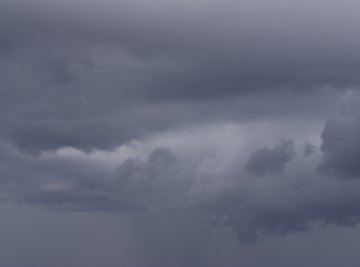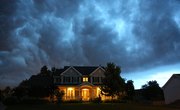
Depending on your perspective and your situation, few sights in nature are quite so foreboding as a black-bellied cloud looming on the horizon. A picnicker or baseball player doesn’t like the looks of it, but a farmer surveying her thirsty field probably does. Rain-bearing clouds such as nimbostratus and cumulonimbus (also called thunderheads) classically show these heavy gray or nearly black bases, but non-precipitating clouds of sufficient depth – or those cast in shadow – can also exhibit dark undersides.
A Little Background: The Composition of Clouds
To talk about the color variation of clouds, we need to understand their basic composition. Clouds form when moist air parcels cool enough for their water vapor to condense into droplets, which may occur when heated air rises into the atmosphere, for example, or when an air mass shoves up over a mountain. If the temperature is cold enough, a cloud may also create ice crystals. If these droplets and/or crystals grow large enough in size – by merging with one another, basically – they may become too heavy to remain aloft and fall as precipitation: rain, snow, hail or graupel.
The Latin word nimbus means “dark cloud” or “rain storm,” and meteorologists use it to classify two of the major types of rain-bearing clouds: nimbostratus, layered rain clouds that don’t produce lightning, and cumulonimbus, deep cumulus clouds generating lightning, thunder and heavy downpours.
Sunlight and Cloud Cover
A clear sky during daytime appears blue because its tiny atmospheric molecules and particles selectively scatter the short blue wavelength of visible light. The water droplets and ice crystals of a cloud, while still miniscule to the naked eye, are larger than those atmospheric particles and scatter all wavelengths of visible light, producing the bright white of a typical cloud.
The Darkness of Clouds
Clouds that grow deep or tall enough look like gray clouds to an observer because less light is reaching their bases: The white tops and sides of the cloud scatter most of the sunlight, allowing less to pass through to the interior and bottom. Larger water droplets are more effective than smaller ones at absorbing rather than scattering sunlight, and can thus create a darker shade. A sheet of stratus clouds covering the sky – called opacus – also naturally blocks sunlight and takes on a gray cast.
It’s also possible for clouds to look dark simply because they’re in the shadow of a nearby cloud, or because the setting sun is only illuminating their tops. Your position as an observer in relation to the cloud and the sun matters in other ways, too: If you’re between the sun and a tall cumulus, the cloud appears a dazzling white, but on the other side you’ll see it as gray because of the blocked and scattered rays.
Dark Rain Clouds
As the above discussion suggests, a dark-bottomed cloud doesn’t necessarily mean an impending downpour, though those with a deep bruised gray or blackish underside certainly warrant attention. Nimbus clouds get their intimidating look from the scattering of sunlight at their upper reaches and margins, and the absorption of sunlight by large water droplets, Again, those larger droplets absorb more sunlight, so a darkening cloud may indicate one in which water droplets are getting heavy enough to begin falling. Dark storm clouds also cast shadows: The “anvil" of a full-grown cumulonimbus, for example, may shroud the cloud’s trailing edge.
One visual clue to distinguish between your garden-variety dark cloud that’s simply deep enough to limit sunlight transmission and an actual rain-bearing cloud is the latter’s fuzzy-looking base, created by falling precipitation. A big thunderhead may also show a fuzzy, if bright, crown, which is the result of water droplets turning to ice at the high altitude of the cloud top.
References
About the Author
Ethan Shaw is an independent naturalist and freelance outdoors/nature writer based in Oregon. He holds a B.S. in Wildlife Ecology and a graduate certificate in G.I.S. from the University of Wisconsin-Madison. His primary interests from both a fieldwork and writing perspective include landscape ecology, geomorphology, the classification of ecosystems, biogeography, wildlife/habitat relationships, and historical ecology. He’s written for a variety of outlets, including Earth Touch News, RootsRated, Backpacker, Terrain.org, and Atlas Obscura, and is presently working on a field guide.
Photo Credits
Hemera Technologies/AbleStock.com/Getty Images
